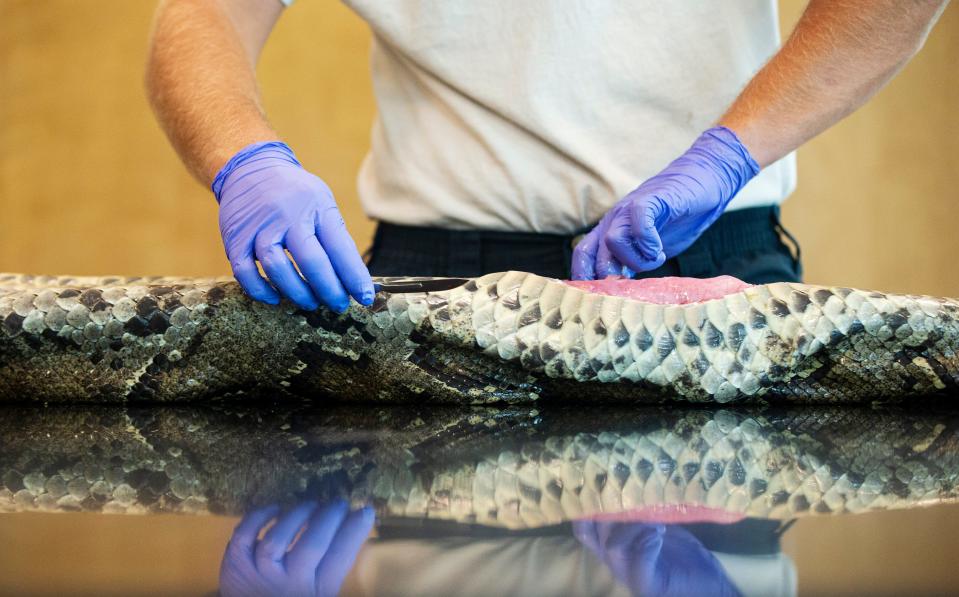Help support efforts to research and remove threat of Burmese pythons in Florida
As a wildlife biologist at the Conservancy of Southwest Florida tracking invasive Burmese pythons for the past ten years, I can share a frontline perspective on the issue for our region. This apex predator from southeast Asia is one of the largest species of snake on the planet and has a wild population firmly established and expanding throughout the Greater Everglades. Pythons are now documented north of Lake Okeechobee. They are an impressive animal and the threat they pose to our native Florida wildlife is real. What have we learned while tracking the python population in this region and what can we apply moving forward?

In the past ten years our team of biologists have captured and removed over 1,000 pythons containing over 10,000 eggs and weighing in excess of 30,000 pounds from an area less than 150 square miles in southwestern Florida. This includes the largest female python captured in Florida by weight at 215 pounds and 18 feet (containing 122 developing eggs) and the largest male python at 140 pounds and 16 feet. Both of those animals had the remains of white-tailed deer hooves inside their stomach.
Amazing python photos: 28 of the best Burmese python photos from our archives
White-tailed deer are the primary prey for the Florida panther and we observe deer predated by pythons often while conducting necropsies at the Conservancy’s lab. This should sound an alarm, a wildlife 9-1-1. In addition, our research partners have identified 24 mammal, 47 bird and three reptile species predated by pythons throughout Florida. We have also interacted with rural landowners that have lost domestic goats and birds to pythons highlighting that the python impact goes beyond native wildlife.
Throughout the Conservancy’s innovative tracking program, we have frequently found elusive pythons underground and within gopher tortoise or armadillo burrows. They utilize these features to seek refuge and to lay eggs. This behavior may allow them to survive during cold weather events and expand their range farther north. We have also documented pythons 15 miles offshore in the Gulf of Mexico that were captured by local stone crab captains. This is the farthest offshore pythons have been reported worldwide, illustrating that water is not a barrier for pythons, it is yet another way for them to move and expand their range. This is a lot of information to consider. What does it mean for our region, what does it mean for us?
I have walked in on thousands of observations of pythons in the wild and can report that we are not on the menu. When encountered they will always try to hide or escape, but like any wild animal they will defend themselves when they are handled or disturbed. It is orders of magnitude more dangerous to drive around town during season than to wrangle a python. It is also important to realize that pythons are creatures of cover and they do not prefer to take up residence in the urban environment. Most people will never see a python or need to worry about them on their property. A dispersing snake can show up in atypical places but rural lands and areas adjacent to extensive green space can increase the likelihood of an encounter. What can you do if you cross paths with a python? Let me share a quick example to help answer this question.
An active, retired couple from Naples with an understanding of native and invasive wildlife were walking down a paved trail in a nature preserve a few seasons back. They turned a bend in the trail and an 8-foot python was stretched out and moving across the trail. They stopped a safe distance away, properly identified it as a python, and made a call to the Florida Fish and Wildlife Invasive species Hotline at 1-888-Ive-Got-1. The call was routed to a wildlife responder who was located 15 minutes away. The couple did not startle the animal and observed where it went into the bushes to hide. The responder showed up and quickly captured the snake by hand, contained it in a capture bag and put it into a lockable tub. The animal was transported to the Conservancy where it was humanely euthanized and scientific information collected. Cool calm and captured, a perfect scenario of working with our community to tackle this issue.
Pythons caught on video: Pythons caught on video include record catch and hunting adventure
It is truly going to take a village to attempt to suppress the local python population. Federal, state and tribal agencies and NGOs like the Conservancy are in the fight but the python is beyond the ability of one single entity to grapple. As we build resiliency into our region to weather storms and rising water levels, we need to develop a more integrated strategy that is realistic, efficient, and based on sound science to address this expanding threat. Let’s get active and in the battle: Help support the crucial efforts to research and remove invasive pythons.
Ian Bartoszek is Environmental Science coordinator at the Conservancy of Southwest Florida.
This article originally appeared on Fort Myers News-Press: Python research, field work critical in battle with invasive snake

